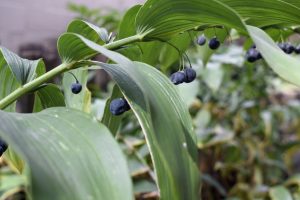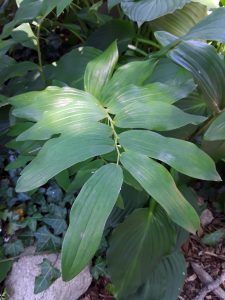Solomon’s Seal

Polygonatum biflorum leaves (Common name ‘smooth Solomon’s seal) are very similar to those of both false Solomon’s seal and starry false Solomon’s seal. They’re alternatively attached as they climb the horizontally arching stem zigzagging their way a bit between them. The big difference, however, lies in the flowers and fruit, which is why these species are classified in different genera. True Solomon’s seal flowers are tube-shaped bells hanging from the leaf axils hidden beneath the leaves as they go up the stem — so very different from false and starry, whose star-shaped flower clusters form at the tip (or terminal end) of the stems. Berry color is different in the fall as well, but if you come upon any of these plants in the springtime before flowers form, their leaf patterns and growth shape do bear a very close resemblance to one another.
Looking closely at the way smooth Solomon’s seal leaves attach to the stem, you will discover that they are clasping. This is in contrast to the other true Solomon’s seal plant, hairy Solomon’s seal (Polygonatum pubescens), which has tiny or no leaf stalks. Hairy has another major difference from which its name arises, that of displaying fine hairs all along the major veins on the leaf’s underside; hence, two very descriptive plant names that distinguish them. Hairy and smooth share similar habitats, but hairy tends to have a bit smaller flowers at 1/2″ long compared to smooth’s which can get to 1″ long. ‘Hairy’ also has a bit shorter and narrower leaves. Both species present their bell-shaped flowers May through June hanging from the stem leaf axils on the undersides of the leaves going up the stem — again very unlike false and starry false Solomon’s seal plants which grow their flowers (and therefore their berries) at the stem’s tip.

The ensuing berries that form on Solomon’s seal plant species ripen in autumn to a deep, dark blue. These berries are toxic and should never be consumed as they cause vomiting and diarrhea due to their high anthraquinone content. This doesn’t seem to affect birds who very much enjoy them. For humans, however, the very young shoots that come up in the springtime are entirely edible, and can be boiled for 10 minutes as a delicious alternative to asparagus. The edibility of spring shoots holds true for both starry and false Solomon’s seal plants as well.
Solomon’s seal plants make beautiful, showy additions to landscaped shade gardens, preferring a rich soil tending toward the moist side — as attractive here as they are when coming across them on wild woodland forays. In the latter circumstance, you will find them blooming at the same time alongside forest neighbors red columbine, starflower, and wood anemone. By the time false Solomon’s seal is blooming, true Solomon’s seal flower petals will be fading but still there — fertilized, and hiding the berries now forming within.
